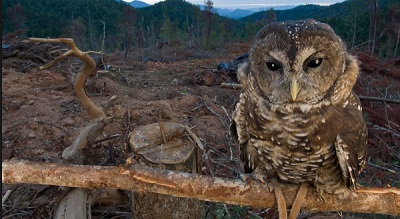Taxonomy
Kingdom |
Phylum |
Class |
Order |
Family |
Genus |
Subspecies |
| Animalia | Chordata | Aves | Strigiformesa | Strigidae | Strix occidentalis | Strix occidentalis caurina |
0
0
Name
- Scientific name: Strix occidentalis caurina.
- Common name: Northern spotted owl.
Habitat and Distribution
- The northern spotted owl is one of the three species of spotted owls, the other two are the California and the Mexican spotted owls.
- Northern spotted owls have historically inhabited forests throughout southwestern British Columbia in Canada, western Washington, western Oregon and northwest California.
- According to Oregon Fish and Wildlife Office suitable land has been reduced by 60% over the last 190 years.
- They inhabit old growth coniferous forest with large trees and layers of branches.
Physical Features
- They have large rounded head with no visible ear tufts. Feathers in the head are dark brown with small white irregular specked spots and dark feathers surrounding their eyes.
- The body is dark brown with white round spots.
- They can be differentiated from the barried owl by its darker feathers and its smaller size.
- Females are larger than males.
- Northern spotted owls have dark colored eyes. Most owls have yellow or orange eyes.
Size and length
- Its length ranges from 16.5 to 19 inches or 42 to 48 centimeters.
- Males weigh 21 oz while females 23 oz.
- Its wingspan is 40 to 50 inches or 101 to 127 centimeters,
Behavior
- Northern spotted owls are nocturnal predators. They sit on branches at night and use their sight to find prey. They silently attack their prey from above.
- They are non migratory birds unless there is a drastic change in its ecosystem.
- These owls are very territorial and need large open space for hunting and nesting.
- They are monogamous and mate for life.
- Northern spotted owls produce sounds to communicate including grunts, groans, hoots and chatters. The most common call is a high pitch “whooo-hu-ho”
Diet
- Northern spotted owls are carnivores. Their diet consists in small rodents, flying squirrels, wood rats and birds.
- They swallow their prey whole. Their pellets contain undigested parts of their prey such as feathers and bones.
Reproduction
- Mating season varies with geographical location. They generally mate from February to March.
- They reach reproductive maturity at 3 years old.
- They lay 1 to 4 eggs and incubation lasts 30 days. During the incubation period the male brings food to the female.
- Northern spotted owls do not build their own nests instead they use abandoned nests of ravens or raptors in the tops of trees or cavities of diseased trees.
The Young
- After hatching the young stay with their mothers for 10 days while the male brings food.
- They stay with their parents for one month after which they find their own food and territory.
- Their feathers are lighter brown.
Life Expectancy
- They live up to 20 years in captivity and 10 years in the wild.
Threats
- Overharvesting of habitat, land conversions and forest fires.
- According to Oregon Fish and Wildlife Office Population is decreasing at an average rate of 2.9% each year.
- The habitat of the barrel owl, a larger and more aggressive owl, overlaps the range of the northern spotted owl competing for habitat and prey. They usually prey on young northern spotted owls.
Conservation Status
- It is considered a threatened species under the Endangered Species Act.
- The IUCN Red List of Threatened Species has not yet assessed the species.
References and further research
Washington Forest Protection Association
Oregon Fish and Wildlife Office
National Park Service – Muir Woods
